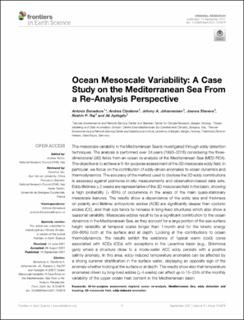| dc.contributor.author | Bonaduce, Antonio | |
| dc.contributor.author | Cipollone, Andrea | |
| dc.contributor.author | Johannessen, Johnny Andre | |
| dc.contributor.author | Staneva, Joanna | |
| dc.contributor.author | Raj, Roshin Pappukutty | |
| dc.contributor.author | Aydogdu, Ali | |
| dc.date.accessioned | 2022-01-27T10:57:14Z | |
| dc.date.available | 2022-01-27T10:57:14Z | |
| dc.date.created | 2021-09-21T14:48:59Z | |
| dc.date.issued | 2021 | |
| dc.identifier.issn | 2296-6463 | |
| dc.identifier.uri | https://hdl.handle.net/11250/2884172 | |
| dc.description.abstract | The mesoscale variability in the Mediterranean Sea is investigated through eddy detection techniques. The analysis is performed over 24 years (1993–2016) considering the three-dimensional (3D) fields from an ocean re-analysis of the Mediterranean Sea (MED-REA). The objective is to achieve a fit-for-purpose assessment of the 3D mesoscale eddy field. In particular, we focus on the contribution of eddy-driven anomalies to ocean dynamics and thermodynamics. The accuracy of the method used to disclose the 3D eddy contributions is assessed against pointwise in-situ measurements and observation-based data sets. Eddy lifetimes ≥ 2 weeks are representative of the 3D mesoscale field in the basin, showing a high probability (> 60%) of occurrence in the areas of the main quasi-stationary mesoscale features. The results show a dependence of the eddy size and thickness on polarity and lifetime: anticyclonic eddies (ACE) are significantly deeper than cyclonic eddies (CE), and their size tends to increase in long-lived structures which also show a seasonal variability. Mesoscale eddies result to be a significant contribution to the ocean dynamics in the Mediterranean Sea, as they account for a large portion of the sea-surface height variability at temporal scales longer than 1 month and for the kinetic energy (50–60%) both at the surface and at depth. Looking at the contributions to ocean thermodynamics, the results exhibit the existence of typical warm (cold) cores associated with ACEs (CEs) with exceptions in the Levantine basin (e.g., Shikmona gyre) where a structure close to a mode-water ACE eddy persists with a positive salinity anomaly. In this area, eddy-induced temperature anomalies can be affected by a strong summer stratification in the surface water, displaying an opposite sign of the anomaly whether looking at the surface or at depth. The results show also that temperature anomalies driven by long-lived eddies (≥ 4 weeks) can affect up to 15–25% of the monthly variability of the upper ocean heat content in the Mediterranean basin. | en_US |
| dc.language.iso | eng | en_US |
| dc.publisher | Frontiers Media | en_US |
| dc.rights | Navngivelse 4.0 Internasjonal | * |
| dc.rights.uri | http://creativecommons.org/licenses/by/4.0/deed.no | * |
| dc.title | Ocean Mesoscale Variability: A Case Study on the Mediterranean Sea From a Re-Analysis Perspective | en_US |
| dc.type | Journal article | en_US |
| dc.type | Peer reviewed | en_US |
| dc.description.version | publishedVersion | en_US |
| dc.rights.holder | Copyright 2021 Bonaduce, Cipollone, Johannessen, Staneva, Raj and Aydogdu | en_US |
| dc.source.articlenumber | 724879 | en_US |
| cristin.ispublished | true | |
| cristin.fulltext | original | |
| cristin.qualitycode | 1 | |
| dc.identifier.doi | 10.3389/feart.2021.724879 | |
| dc.identifier.cristin | 1936659 | |
| dc.source.journal | Frontiers in Earth Science | en_US |
| dc.identifier.citation | Frontiers in Earth Science. 2021, 9, 724879. | en_US |
| dc.source.volume | 9 | en_US |

